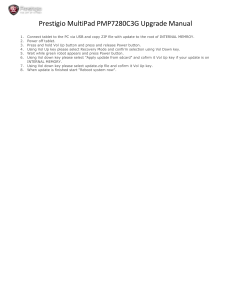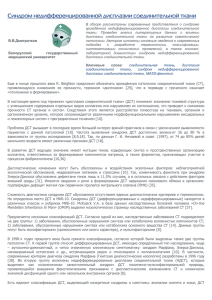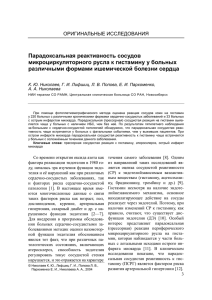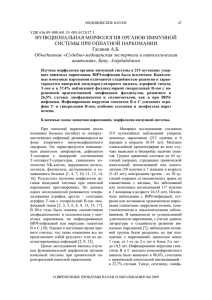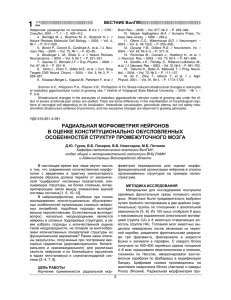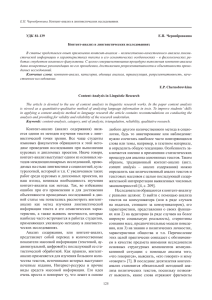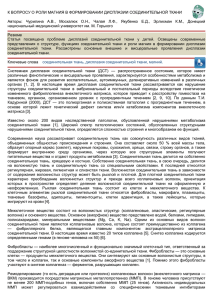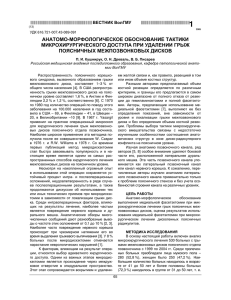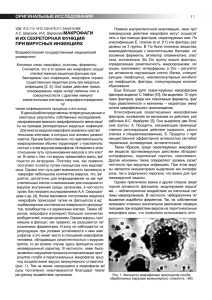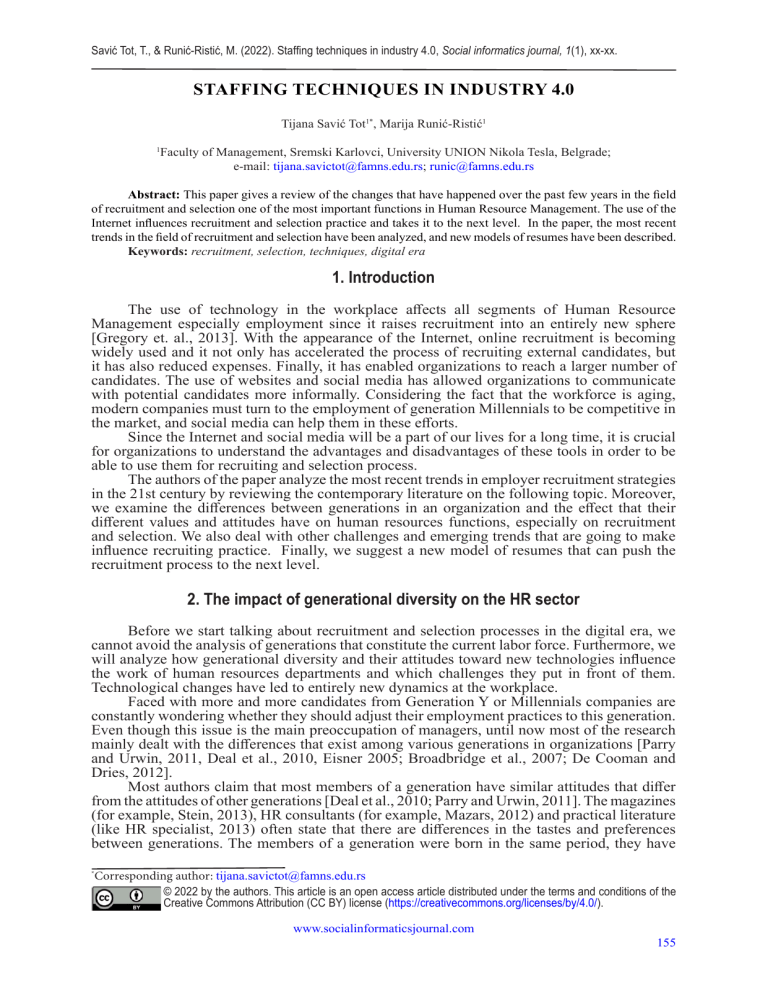
Savić Tot, T., & Runić-Ristić, M. (2022). Staffing techniques in industry 4.0, Social informatics journal, 1(1), xx-xx. STAFFING TECHNIQUES IN INDUSTRY 4.0 Tijana Savić Tot1*, Marija Runić-Ristić1 Faculty of Management, Sremski Karlovci, University UNION Nikola Tesla, Belgrade; e-mail: tijana.savictot@famns.edu.rs; runic@famns.edu.rs 1 Abstract: This paper gives a review of the changes that have happened over the past few years in the field of recruitment and selection one of the most important functions in Human Resource Management. The use of the Internet influences recruitment and selection practice and takes it to the next level. In the paper, the most recent trends in the field of recruitment and selection have been analyzed, and new models of resumes have been described. Keywords: recruitment, selection, techniques, digital era 1. Introduction The use of technology in the workplace affects all segments of Human Resource Management especially employment since it raises recruitment into an entirely new sphere [Gregory et. al., 2013]. With the appearance of the Internet, online recruitment is becoming widely used and it not only has accelerated the process of recruiting external candidates, but it has also reduced expenses. Finally, it has enabled organizations to reach a larger number of candidates. The use of websites and social media has allowed organizations to communicate with potential candidates more informally. Considering the fact that the workforce is aging, modern companies must turn to the employment of generation Millennials to be competitive in the market, and social media can help them in these efforts. Since the Internet and social media will be a part of our lives for a long time, it is crucial for organizations to understand the advantages and disadvantages of these tools in order to be able to use them for recruiting and selection process. The authors of the paper analyze the most recent trends in employer recruitment strategies in the 21st century by reviewing the contemporary literature on the following topic. Moreover, we examine the differences between generations in an organization and the effect that their different values and attitudes have on human resources functions, especially on recruitment and selection. We also deal with other challenges and emerging trends that are going to make influence recruiting practice. Finally, we suggest a new model of resumes that can push the recruitment process to the next level. 2. The impact of generational diversity on the HR sector Before we start talking about recruitment and selection processes in the digital era, we cannot avoid the analysis of generations that constitute the current labor force. Furthermore, we will analyze how generational diversity and their attitudes toward new technologies influence the work of human resources departments and which challenges they put in front of them. Technological changes have led to entirely new dynamics at the workplace. Faced with more and more candidates from Generation Y or Millennials companies are constantly wondering whether they should adjust their employment practices to this generation. Even though this issue is the main preoccupation of managers, until now most of the research mainly dealt with the differences that exist among various generations in organizations [Parry and Urwin, 2011, Deal et al., 2010, Eisner 2005; Broadbridge et al., 2007; De Cooman and Dries, 2012]. Most authors claim that most members of a generation have similar attitudes that differ from the attitudes of other generations [Deal et al., 2010; Parry and Urwin, 2011]. The magazines (for example, Stein, 2013), HR consultants (for example, Mazars, 2012) and practical literature (like HR specialist, 2013) often state that there are differences in the tastes and preferences between generations. The members of a generation were born in the same period, they have Corresponding author: tijana.savictot@famns.edu.rs © 2022 by the authors. This article is an open access article distributed under the terms and conditions of the Creative Commons Attribution (CC BY) license (https://creativecommons.org/licenses/by/4.0/). * www.socialinformaticsjournal.com 155 Savić Tot, T., & Runić-Ristić, M. (2022). Staffing techniques in industry 4.0, Social informatics journal, 1(1), xx-xx. experienced significant life events similarly during the crucial years of forming their personalities [Mannheim, 1952] and they share the same collective cultural field [Eyerman and Turner, 1998]. From the social cognitive aspect, according to the theory of socialization [Ward 1974], the individuals of every generation are influenced by the political, economic or cultural context in which they are developing and the historical events that shape their values [Mannheim, 1952]. Due to the power that these common events have, it is believed that each generation develops a unique set of beliefs and attitudes that influence their behavior (Rider, 1965). Moreover, each generation develops a unique form of behavior based on common experience [Kupperschmidt, 2000]. For example, Generation Y shares common events such as the fall of Berlin Wall, the 9/11 terrorist attacks, etc. Four generations have been identified in western economies, and those are Veterans, Baby Boomers, Generation X, and Generation Y. The progress in medicine and better quality of life have enabled us to live longer, stay healthier longer, and therefore remain at the workplace longer. The data from the last census in the USA show that 13% of the American population is 65 years old or older, and it is believed that the percentage will grow to 20%, or 70 million people, since 2030 [Society for Human Resource Management, 2020]. Since baby boomers live longer and stay healthy longer, 80% of this population plans to continue to work even after the age of 65 [Society for Human Resource Management, 2021]. This “gray labor force,” or Veterans, can create many challenges to organizations, and therefore to human resources departments. Older workers are often more resistant to changes, especially while introducing radically new programs and using new technologies that lead to a complete break from a long-standing way of functioning things. They can also enlarge the medical expenses of companies in comparison to their younger colleagues. Less opportunity for advancement is available to younger workers when older workers do not retire on time. Moreover, in many cases, older workers ask for bigger salaries even though they have skills and abilities that are less competitive comparing to the skills and abilities of their younger colleagues, especially skills that are related to the use of technology [Kwoh, 2012]. However, it is necessary to state that older workers can be very productive, and even more productive than their younger colleagues can. Society often tries to devalue more elderly citizens, and such prejudices can be found in an organizational context [Society for Human Resource Management, 2021]. However, older workers can be more loyal to their employers than their younger colleagues. They also possess significant knowledge about the organization and industry, as well as the key contacts within their professional network. Baby boomers belong to the generation born between 1945 and 1962, and they are now in the middle of their careers. Employers have found out that the offer of the employees from this generation is bigger than their demand. As the members of this generation climb the hierarchical ladder for higher managerial positions, there are fewer available jobs at their disposal, and the struggle between baby boomers becomes fierce. Many organizations have been flattened, and many hierarchical levels have been eliminated with the expanding use of technology [Robinson, 2002]. Many jobs performed by middle-level management are now carried out by new technologies. Considering all these factors, it is clear that many of these individuals will never make any progress further than middle-level management. It can be very frustrating for baby boomers who have been employed in an organization for many years and who have seen their older colleagues making progress. This situation puts on significant challenges for HR in satisfying and engaging the baby boom generation. HR should find ways how to retain them and keep them motivated even though they have come to the point in their careers when they should make progress, and they cannot do that. Baby Boosters are the sub-generation, the generation between Baby Boomers and Generation X. It is a generation born during the decrease of the birth rate in the period from 1963 until the middle of the 1970s. This generation should also have fewer expectations concerning the pace of their careers. Baby Boomers have created a bottleneck in the hierarchical ladder. Until the Baby Boomers does not retire, there are fewer opportunities for baby boosters to make career progress in larger organizations. On the other side, Baby Boosters who usually occupy lower and middle levels of management often get higher salaries than some Baby Boomers. For many industries, and especially those that develop fast, such as multimedia and IT, this generation possesses skills and abilities that Baby Boomers lack. Due to this, Baby Boosters earn more than Baby 156 www.socialinformaticsjournal.com Savić Tot, T., & Runić-Ristić, M. (2022). Staffing techniques in industry 4.0, Social informatics journal, 1(1), xx-xx. Boomers, and it is possible that employees in their 40s earn much more than their 20-30 year older colleagues [Babcock, 2021]. Generation X has created an entirely different workplace environment. Generation X includes employees born between the late 1960s and the late 1970s. Many of these individuals have grown up in divorced families and have developed a significant degree of tolerance and the ability to adjust. They have witnessed the members of their families being fired during economic crises, and it has influenced their limited loyalty to their employer. They have also used computers and other modern technologies all their lives, and since their early age, they have been exposed to constant changes in their daily lives. More importantly, they have attitudes and perceptions regarding work that are significantly different from the attitudes of the previous generations. It includes the expectation that they have more control over the work they perform. They regard themselves as independent consultants, and not as employees. They do not care so much to have a safe job, and they do not expect long-term employment. The important thing for them is to have the opportunity for personal growth and creativity at work [Harvey, 2000]. Despite variations among studies, the most common definition of Generation Y relates to the people born after 1982 [Strauss and Hove, 1991]. Other names used for this generation are: `Millennials`, `Net Generation`, ` Digital Natives` and ‘Generation Next .’ By some authors, Generation Y is also called ‘’the Baby Boom Echo’’ because this generation consists of the children of the Baby Boomers [Ng et al. 2010]. Now Baby Boomers represent the largest generation among the current workforce. However, in 20 years their place is going to be taken over by Generation Y [Gillbert, 2011], which has just started to become a part of the workforce. Millennials are often described as a homogeneous group with values, attitudes, behavior or expectations different from the previous generations [Eisner, 2005; Ng et al., 2012]. It is often said that this generation is very educated, open-minded, optimistic, cooperative, influential and sociable [Raines, 2002]. As well as Generation X, they are very skilled and tech-savvy. Since most of them grew up in multicultural surroundings, they have a more global and tolerant view of life [Robinson, 2002]. They are often entrepreneurs. They do not wish to work from an office or to have an actual employer, and they are more willing to work on temporary projects [Society for Human Resource Management, 2020]. The employees from Generation Y appreciate collective and teamwork. They usually have a greater sense of social responsibility in comparison to other generations and value authenticity and transparency. They avoid a dictatorial leadership style, a rigid hierarchy, and a controlling system. They prefer a working environment where their contribution is wanted and where they can actively participate [Hughes, 2011]. Studies are less consistent regarding the expectations of Generation Y about salary. Some authors state that for Millennials salary is less important than other factors, such as a fulfilling personal life [Eisner 2005], while others state that salary is a critical dimension and the main worry of Millennials [Hite and McDonald, 2012]. Montgomery and Ramus [2011] emphasize that the intellectual challenge at work is more important for Millennials than the financial package. Tyler [2007] claims that challenging work and opportunities to develop professionally are the things that Generation Y asks for from their employers. He believes that both factors are more important than salary. Generation Y is in the focus of attention due to the fact that they are just becoming a workforce and have different needs from the previous generations. Table 1 shows some of the key differences between generations that are currently a part of the workforce [Sbatini et al., 2020]. www.socialinformaticsjournal.com 157 Savić Tot, T., & Runić-Ristić, M. (2022). Staffing techniques in industry 4.0, Social informatics journal, 1(1), xx-xx. Table 1. Generations in the Workplace. [Sbatini et al., 20020, pp. 205] During the last couple of years, Generation Y has entered the labor market and that fact raises many questions regarding their attitudes toward work and ways that organizations can attract and retain them. From all the aspects of managing human resources it is clear that there is a great difference between Generation Y and other generations. The question that most companies face today is how to attract employees that belong to Generation Y. According to the studies dealing with recruitment and selection, searching for a job is a dynamic process of decision-making in which business and organizational attributes influence the final decision of the candidates [Montgomeri and Ramus, 2011]. Moreover, they are significant predictors of candidate reactions in all phases of the employing process [Taylor and Bergmann, 1987]. These attributes are dominant since they have a direct positive influence on the candidate’s attraction and their decision to accept or refuse a job offer [Turban et al., 1998]. Many studies have tried to identify a connection between job attributes and candidate preferences for a job. As for Millennials, some studies emphasized their particular expectations regarding job characteristics, reviewing each attribute individually. Based on these studies, Generation Y search for a collective management style, an organizational culture that will support them and for a positive work environment [Eisner 2005; Broadbridge et al., 2007; De Cooman and Dries, 2012]. Generation Y should also love a stimulating work environment that offers the possibility to make progress and long-term career development [Eisner, 2005; Broadbridge et al., 2007; Terjesen et al., 2007; De Cooman and Dries, 2012; Hite and McDonald, 2012]. They will be attracted by an organization that invests in the training and development of its employees [Broadbridge et al., 2007; Terjesen et al., 2007; Martins and Martins, 2012] and ensures different work on an everyday basis [Terjesen et al., 2007]. According to Cennamo and Gardner [2008] and Hite and McDonald [2012], they also need autonomy and independence. This generation values a balance between work and personal life, and personal enjoyment and especially fresh graduates pay particular attention to these things [Eisner, 2005; Cennamo and Gardner, 2008; Hite and McDonald, 2012]. In the next section of the paper, we are going to analyze how the entrance of Generation Y on the labor market and how a greater use of modern technologies has changed a complete approach to the process of candidate recruitment and selection. 158 www.socialinformaticsjournal.com Savić Tot, T., & Runić-Ristić, M. (2022). Staffing techniques in industry 4.0, Social informatics journal, 1(1), xx-xx. 3. Evolution in recruitment Not so long ago recruitment was a much simpler process. Hireology, a leading organization for talent assessment in the USA recently released an infographic titled “The Evolution of Finding Candidates” that provides a fascinating account of how recruitment and selection have evolved over time. Employee referrals date back to ancient Rome, and the first candidate recruitment happened in 49 BC. Between the 1950s and 1980s, 75% of the candidates were sourced from newspaper ads. The 90s were the decade of the Internet job boards. Careerbuilder was founded in 1995. In 2000 recruiting turns to the Internet. In 2002 6% of job seekers used the Internet, in 2003 46% used the Internet, and in 2006 even 96% of job seekers used the Internet. In 2001 96% of large companies had official websites for recruiting [Cappelli, 2001]. Since 2012 the Internet has been the primary source that companies have used for recruiting candidates [Borgerson, 2020]. Nowadays recruiting has not changed as a process, it is still the same – a vacant workplace needs to be filled with the best possible available candidate. The environment, society, tools and technologies that are used for recruiting have changed. The behavior of the employees, expectations, and generations have changed, and therefore organizations need to modify the way they recruit talent. Dessler defined employee recruiting as “finding and / or attracting candidates for open positions in an organization” [Dessler, 2021, pp. 146]. Traditionally, this concept referred to the employers and not to the employees. Today this definition also includes those who seek a job. Some time ago candidates struggled to attract the attention of recruiters, and nowadays recruiters struggle to draw the attention of potential candidates, and they use the Internet and social media for that purpose. The transfer of the market`s focus from the employer to the candidate will demand the organization to reshape the function of recruiting and make it a well-designed marketing machine that can nourish long-term relationships with the right candidate. Traditionally, it was believed that recruiting is a function within HR. Today it is thought that recruiting is a marketing challenge since finding and keeping talented employees does not differ much from finding and keeping buyers. Traditional recruiting needs to include in its function the component of marketing and the most important tool is social media. Traditional ways of recruiting enabled companies to advertise their vacant positions to potential employees. New technologies and social networks enable potential employees to advertise themselves on the sites or social platforms of potential companies. In addition, recruiting has now become much more than a way to fill the positions. Among other things, it implies the involvement of candidates in creating a positive image of the company. Research concerning the recruitment and selection of candidates have become immense [Breaugh, 2008], but there are still not enough research on the topic of using the Internet and social networks for recruiting. So far only a few authors from the area of human resources and organizational psychology dealt with this subject [Cober et al., 2004; Highhouse and Hoffman, 2001; Levis and Harris, 2003; Boswell et al., 2003; Dineen et al., 2007]. 4. Recruitment through websites One of the important mechanisms of online recruitment is company`s website that often has a significant role in recruiting candidates [Afolabi, et al., 2018;. Chapman and Vebster, 2003]. Chartered Institute of Personnel and Development [2009] states that 75% of big-brand companies use their sites for attracting candidates who are interested. They also state that big companies like to use their sites more than sites such as Monster and HotJobs. Companies prefer to use their sites for recruiting since these platforms can generate many applications from unqualified candidates [Steel, 2007]. These sites would have greater significance if they could give feedback on how a potential candidate fits in the organizational culture [Hu et al., 2007]. According to Gregory et al., [2013] research show that 50% of the new employees have been recruited through the Internet [Cober and Brown, 2006], and it is estimated that organizations that use e-recruiting cut their expenses by even 87% [Maurer and Liu, 2007]. Melián-González and Bulchand-Gidumal [2017] shows in Glassdoor research shows that when candidates have access to information about a job and company—before deciding www.socialinformaticsjournal.com 159 Savić Tot, T., & Runić-Ristić, M. (2022). Staffing techniques in industry 4.0, Social informatics journal, 1(1), xx-xx. whether to apply or accept a job offer—employers have seen an approximate average of 22 percent reduction in turnover. Organizations that use sites for employees’ recruitment should make sure that the sites are attractive and easy to use [Rynes and Cable, 2003]. Some authors in their studies have analyzed the characteristics of sites that influence the decision of a potential candidate to apply for the position within the organization [Braddy et al., 2003; Cober et al., 2003; Cober et al., 2006; Coyle &Thorson, 2001; Williamson et al., 2003; Zusman & Landis, 2002; Gregory et al., 2013]. Braddy [2008] in his study focused on how a website should be designed and what kind of content it should have to make a positive impression on a candidate looking for a job. He also tried to determine what kind of website content could be the best in order to show a candidate to what extent he fits in the organizational culture [Braddy et al., 2008]. Gregory et al. [2013] concluded that it is paramount that the site is user-friendly, nicely designed, and has precise and accurate information about the company. He also determined that there is a relationship between the candidates` attitudes towards the company`s site through which they are employed and the relationship towards the organization. In other words, a poorly designed site with insufficient and inaccurate information has a negative impact on the company`s image. The negative company’s image leads to decreasing of the number of candidates that are interested in applying to open positions within the company [Gregory et al., 2013]. One of the most detailed studies regarding this subject has examined the relationship between the candidates` attitudes towards the organization and its website and finally how it affects their intention to apply for the position in the organization [Afolabi, et al. 2018]. There are also sites where it is possible to leave a comment about the current employer which greatly helps future candidates. Van Hoye and Lyevens [2007] determined that available information about companies on an independent site is more precise and valuable than those offered on the company`s site. On these sites, comments are not left only by the employees, but the candidates can also share their experience they had with a company while applying for a job. Public Ranking and Rating platforms, such as Yelp, Netflix, Amazon, and Glassdoor make us realize the importance of the opinion that candidates and employees have about the company. The comments on these sites have a major effect on the company`s image. We may say that the time has gone when the organizations treated the candidates badly without anyone having the information about that. 5. Social Media Recruitment Most organizations today employ Millennials which significantly influences the techniques and tools they are going to choose to recruit, select and motivate them [Solnet and Hood, 2008]. There are few studies regarding how social media are used for recruiting Millennials. Since they use social networks a lot, it is most logical that these tools are also used for their recruiting. Solnet and Hodd [2008] claim that organizations can become more attractive to potential Millennials employees if they start using social networks for communication with them. Many companies motivate their clients, and therefore their potential employees, to connect with them on social networks. In this way corporations can through informal conversation present the opportunities for employment in their companies and motivate potential candidates to apply for a job. They can also find out more about their potential employees by studying their profiles on Facebook, Instagram, LinkedIn, and Twitter. On the other side, potential employees can find out more about the organizational structure and culture of the company and receive more information about the company from its employees on social networks. Candidates can sometimes learn more about the organization on the basis of some informal comments on social networks than through the formal ways from the organization. When used successfully, recruiting through social media can improve the employer`s brand and can give the organization a new, modern identity. Social media can certainly influence the activities of recruiting in many organizations, but they should be managed carefully and the proper processes and technologies must support them. Holland [2021] in his article stated the advantages and disadvantages of the use of social networks in the purpose of recruiting. He emphasizes that when companies use social media for recruiting it is crucial that they maintain the communication with the candidates in all phases 160 www.socialinformaticsjournal.com Savić Tot, T., & Runić-Ristić, M. (2022). Staffing techniques in industry 4.0, Social informatics journal, 1(1), xx-xx. of employment. Recruiting through social media enables faster communication, more rapid responses and has a personal note since through social media you communicate with a real person and not with a machine [Holland, 2021]. While using social media for recruiting it is essential to plan and to know which group of potential candidates is the target, and based on this one will know which media channel to choose. The selection of the proper media channel does not depend only on the type of candidates we want to attract but also on the industry and country in which we do business. Social networks that recruiters and job seekers mostly use are Facebook, Twitter and LinkedIn. It is not secret that LinkedIn has had a meteoric rise to prominence in the job space, but the importance of social tools is becoming apparent across more avenues. Facebook in 2020 launched a job search tool that aggregates posts from external sites and adds a social layer [Facebook, 2021]. Twitter has long been a place to connect with people in your industry, and this channel will become more important as traditional job search methods lose their appeal. The research has shown that most of the job seekers (83%) use Facebook when they look for the job while recruiters (65%) don’t rely so much on this media when they search for the candidates. On the other hand, 94% of recruiters is active on LinkedIn while only 36% of job seekers use this social media. (Figure 1) Fig. 1. [Jobvite, 2020, pp.5] We expect to see traditional job boards to collaborate with existing social networks or develop their social tools (e.g. ratings, recommendations, social connections to the company, etc.) to complement their current offering. As most career coaches tell, it is just as much about who you know as what you know, and these social elements enable job seekers to build their network in a targeted manner. 5.1. Facebook Facebook is the most famous and influential of all social networks, with 1.28 billion of active monthly users, and 802 million of active daily users based on the information from January 2021 [Facebook, 2021]. Shahid [2019] and his associates suggested making a Facebook fan page that would be used for recruiting (Fig 2). His idea was that Fan page would not only attract potential candidates, but it would also encourage them to apply to open positions when they occur. This strategy consists of three steps: Attract, Care and Initiate, that help employers use Facebook for recruiting students that are about to graduate. With Attract strategy the employer will identify and attract potential candidates to the Fan Page. In the next phase, the employer will develop Care strategy to provide appropriate content interested to the fans. The aim of this strategy is to make sure that the fans are interested in our company and that they frequently visit the Fan Page. The content will mostly consist of something that is useful to students in their search for www.socialinformaticsjournal.com 161 Savić Tot, T., & Runić-Ristić, M. (2022). Staffing techniques in industry 4.0, Social informatics journal, 1(1), xx-xx. jobs. The last step, Initiate, is the most important since it motivates graduates to apply when there is an open position in a company. The last step is crucial. The initiate strategy is based on the theory of planned behavior [Ajzen,1991]. Fig. 2. Facebook recruiting strategy [Shahid, 2019, pp. 136] 5.2. LinkedIn On the other side, LinkedIn, as a professional social network, is often used for recruitment. LinkedIn was founded in 2002 and presents a professional social network with 65 million registered users in over 200 countries and territories all over the world [Doherty, 2010]. Companies advertise their vacant positions through LinkedIn. It is mostly used for search of passive candidates. Recruiters search the information about all 65 million members of LinkedIn, and by doing so, they can proactively target passive candidates more efficiently. 5.3. Twitter Twitter is often used for advertising vacant workplaces and by using hashtags targets a particular group of people. IT companies all over the world currently face a significant problem of recruiting talented employees and to succeed they use all possible means of recruiting that are available. One of the leading IT companies in India, HCI with 31 branches all over the world, when faced with this problem, decided to start an aggressive campaign on Twitter to attract talented young people from generation Y. The campaign was called #coolestinterviewer and they interviewed through Twitter candidates for five positions in the company. 250000 candidates from 60 countries all over the world participated in the campaign. After the campaign had finished, the company had 200000 followers on Twitter more than its competitors had. The campaign was the breaking news on 60 national and international media which had the commercial value of US $1 million [Kumar and Srivastava, 2016]. It is just one of the examples how companies can efficiently use Twitter for recruiting with minimum expenses. Although Facebook, Twitter, and LinkedIn are the most common social media channels used for recruiting, there are also some other channels that are being used. For example, Oxfam uses YouTube to advertise open positions and to show what skills and abilities are needed for the candidates in order to apply [Holland, 2021]. 6. The use of social media for selection and screening Research shows that more and more human resource managers use social networks for screening candidates [Klark and Roberts, 2010]. Lately, some organizations started to deal with 162 www.socialinformaticsjournal.com Savić Tot, T., & Runić-Ristić, M. (2022). Staffing techniques in industry 4.0, Social informatics journal, 1(1), xx-xx. issues concerning under which circumstances or how recruiters should use social media for choosing candidates for the job or monitoring current employees [Smith and Kidder, 2010]. Caers and Castelyns [2011] claim that employees during the process of selection should consider only factors that are connected to the job. Since individuals post information about themselves on social networks, they are available to organizations in which they apply for positions. Thus, it is possible that even before a candidate is asked for an interview the information from the social network has created prejudices about the candidate [Caers and Castelyns, 2011]. Inappropriate photographs and profiles sometimes reduce chances for the employment of the candidates [Newcombe, 2013]. It can be said that the decision of the employer to investigate all available information about the candidate is entirely legitimate from the point of view of the screening process [Pate, 2012]. Some studies [Kluemper et al., 2012] have shown the connection between employees’ performance and their Facebook profile of the employees. Many organizations consult LinkedIn which is a professional social network, and through this social network, they can see the qualifications of the candidate and their career history. However, more and more organizations turn to Facebook for recruiting, even though this is not the primary aim of this social network [Smith and Kidder, 2010]. Screening of the candidates through Facebook, Twitter, and Instagram is often used to understand better the character of the potential employees, their personalities and to see if they will be able to fit into the organizational culture. Potential legal problems may occur during the use of social media for recruiting and selection. From the perspective of the employee, it may be considered discrimination or an invasion of privacy. It is doubtful which information can be regarded as information related to the business life of the candidate, and which to the private life. The main difference between Facebook and LinkedIn is that Facebook focuses on connecting to friends and information exchange, while LinkedIn enables professionals to connect, advertise their skills and share information concerning their work. Caers and Castelyns [2011] conclude that Facebook belongs to the private sphere of an individual, whereas LinkedIn belongs to the business sphere. Accordingly, the employers should be focused more on the use of LinkedIn than on Facebook while screening candidates. Moreover, the use of social media for the process of selection of the candidates raises the question regarding the reliability of the information that can be found on them. Many psychological studies have shown that people tend to self-promote on social networks and that they often post inaccurate information or exaggerate it [Buffardi and Campbell, 2008; Epstein, 2008]. When candidates are applying for an open position, they must be aware of both positive and negative sides that profiles on social networks have. An online identity has a significant influence during the process of recruitment and selection since the first impression, whether positive or negative, can have a huge effect on the further process of selection. 7. Conclusion The use of the Internet and social media has significantly changed the way the companies recruit the candidates. It is essential for companies to shift their focus from gathering CVs to a more personal form of recruiting. If companies are not able to do that, then they would have to reconcile with the fact that top talents will build a relationship with their competitors not with them. Ordinary resumes are becoming more useless to recruiters. Rynes et al. [2003] said that the real skills of people are not in correlation with what is written in the resume. It requires more time so that companies would completely understand the challenges that online and social media recruiting carry with them. It would be good to make procedures and manuals for the use of social media and the Internet for recruiting. These procedures should also include the legal implications that this type of recruiting may have. HR departments would have to cooperate more with other departments. IT departments may help them in creating websites for recruiting, and marketing departments in making a strategy for online communication. Finally, HR recruiters would have to master some new skills to be able to successfully use the Internet and social media for attracting potential candidates. www.socialinformaticsjournal.com 163 Savić Tot, T., & Runić-Ristić, M. (2022). Staffing techniques in industry 4.0, Social informatics journal, 1(1), xx-xx. References Ajzen, I. (1991). The theory of planned behavior, Organizational Behavior and Human Decision Processes, Vol. 50 No. 2, pp. 179-211. Afolabi, A. O., Oyeyipo, O. O., Ojelabi, R. A., & Amusan, L. M. (2018). Construction Professionals’ perception of a Web-Based Recruiting System for Skilled Labour. Journal of Theoretical & Applied Information Technology, 96(10). Babcock, P. (2021). Collaboration in the Intergenerational Workplace, Society for Human Resource Management, August 2. Borgerson E. (2020). The Evolution of Finding Candidates, Hireology available at http://www.hireology.com/blog/bid/93197/ The-Evolution-of-Finding-Candidates-A-Recruiting-INFOGRAPHIC Boswell, W.R., Roehling, M.V., LePine, M.A. and Moynihan, L.M. (2003). Individual job choice decisions and the impact of job attributes and recruitment practices: a longitudinal field study, Human Resources Management, Vol. 42 No. 1, pp. 23-37. Brady, P.W., Thompson, L.F., Wuensch, K.L. and Grossnickle, W.F. (2003). Internet recruiting, the effects of webpage design features, Social Science Computer Review, Vol. 21 No. 3, pp. 374-385. Breaugh, J.A. (2008). Employee recruitment: current knowledge and important areas for future research, Human Resource Management Review, Vol. 18 No. 1, pp. 103-118. Broadbridge, A., Maxwell, G. and Ogden, S. (2007). Experiences, perceptions and expectations of retail employment for Generation Y, Career Development International, Vol. 12 No. 6, pp. 523-544. Buffardi, L.E. and Campbell, W.K. (2008). Narcissism and social networking sites, Personality and Social Psychology Bulletin, Vol. 34 No. 3, pp. 597-626. Caers, R. and Castelyns, V. (2011). LinkedIn and Facebook in Belgium: the influences and biases of social network sites in recruitment and selection procedures, Social Science Computer Review, Vol. 29 No. 4, pp. 437-448. Cappelli, P. (2001). Making the most of on-line recruiting, Harvard Business Review, 79, 139–146. Cennamo, L. and Gardner, D. (2008). Generational differences in work values, outcomes and person-organisation values fit, Journal of Managerial Psychology, Vol. 23 No. 8, pp. 891-906. Chartered Institute of Personnel and Development (2020). E-recruitment factsheet, available at: www.cipd.co.uk/subjects/ recruitment/onlnruit/onlrec.htm. Cober, R. T., Brown, D. J., Keeping, L. M., & Levy, P. E. (2004). Recruitment on the net: How do organizational web site characteristics influence applicant attraction? Journal of Management, 30(5), 623–646. Cober, R.T. and Brown, D.J. (2006). Direct Employers Association Recruiting Trends Survey, Booz, Allen and Hamilton, Washington, DC, available at: www.jobcentral.com/DEsurvey.pdf Cober, R.T. and Brown, D.J. (2006). Direct Employers Association Recruiting Trends Survey, Booz, Allen and Hamilton, Washington, DC, available at: www.jobcentral.com/DEsurvey.pdf Deal, J.J., Altman, D.G. and Rogelberg, S.G. (2010). Millennials at work: what we know and what we need to do (if anything), Journal of Business and Psychology, Vol. 25 No. 2, pp. 191-199. De Cooman, R. and Dries, N. (2012). Attracting Generation Y: how work values predict organizational attraction in graduating students in Belgium, in Ng, E., Lyons, S.T. and Schweitzer, L. (Eds), Managing The New Workforce: International Perspectives on The Millennial Generation, Edward Elgar Publishing, Northampton, MA, pp. 42-63. Dessler, G. (2021), Human Resource Management, 13th Edition, Prentice Hall, NJ. Dineen, B. R., Ash, S. R., & Noe, R. A. (2002). A web of applicant attraction: Person-organizational fit in the context of webbased recruitment, Journal of Applied Psychology, 87(4), 723–734. Dineen, B.R., Ling, J., Ash, S.R. and DelVecchio, D. (2007). Aesthetic properties and message customization: navigating the dark side of web recruitment, Journal of Applied Psychology, Vol. 92 No. 2, pp. 356-372. Eisner, S.P. (2005). Managing Generation Y, Advanced Management Journal, Vol. 70 No. 4, pp. 4-15. Epstein, D. (2008). Have I been Googled? Character and fitness in the age of Google, Facebook and YouTube, The Georgetown Journal of Legal Ethics, Vol. 21 No. 3, pp. 715-727. Eyerman, R. and Turner, B. (1998). Outline of a theory of generations, European Journal of Social Theory, Vol. 1 No. 1, pp. 91-106. Facebook (2020). Facebook newsroom: key facts, available at: http://newsroom.com/keyfacts Facebook. (2021). Introducing graph search, available at: www.facebook.com/about/graphsearch Gilbert, J. (2011). The Millennials: a new generation of employees, a new set of engagement policies, Ivey Business Journal, Vol. 75 No. 5, pp. 26-28. Gregory, C.K., Meade, A.W. and Foster Thompson, L. (2013). Understanding internet recruitment via signaling theory and the elaboration likelihood model, Computers in Human Behavior, Vol. 29 No. 5, pp. 1949-1959. Harvey, B. H. (2000). Technology, Diversity and Work Culture—Key Trends in the Next Millennium, HR Magazine, 45, (7), p. 59. Highhouse, S., & Hoffman, J. R. (2001). Organizational attraction and job choice. In C. L. Cooper & I. T. Robertson (Eds.). International review of industrial and organizational psychology (Vol. 16, pp. 37–64). New York: John Wiley & Sons. Hite, L.M. and McDonald, K.S. (2012). Career counseling for Millennials: practitioners’ perspectives, in Ng, E., Lyons, S.T. and Schweitzer, L. (Eds), Managing The New Workforce: International Perspectives on The Millennial Generation, Edward Elgar Publishing, Northampton, MA, pp. 204-222. Holland, F. (2021). Recruitment of talent: social media – friend or foe?, HR Magazine, 24 October, available at: www.hrmagazine. co.uk/hro/features/1075088/recruitment-talent-socialmedia-friend-foe. HR Specialist (2013). 8 keys for managing Generation Y employees, June, p. 2. Hu, C., Su, H. and Chen, C. (2007). The effect of person-organization fit feedback via recruitment websites on applicant attraction, Computers in Human Behavior, Vol. 23 No. 5, pp. 2509-2523. Hughes, K. (2011). What Does Generation ‘Why?’ Really Want?, Society for Human Resource Management, February 9. Jobvite (2020). Job Seeker Nation Study, available at: http://web.jobvite.com/rs/jobvite Kluemper, D.H., Rosen, P.A. and Mossholder, K.W. (2012). Social networking websites, personality ratings and the organizational context: more than meets the eye?, Journal of Applied Psychology, Vol. 22 No. 2, pp. 1143-1172. 164 www.socialinformaticsjournal.com Savić Tot, T., & Runić-Ristić, M. (2022). Staffing techniques in industry 4.0, Social informatics journal, 1(1), xx-xx. Kupperschmidt, B.R. (2000). Multi-generation employees: strategies for effective management, Health Care Manager, Vol. 19 No. 1, pp. 65-76. Kwoh, L.(2012). Firms Hail New Chiefs (of Diversity), Wall Street Journal, January 5, p. 10. Lievens, F., & Harris, M. M. (2003). Research on Internet recruiting and testing: Current status and future directions. In C. L. Cooper & I. T. Robertson (Eds.). International review of industrial and organizational psychology (Vol. 16, pp. 131–165). New York: John Wiley & Sons. Mannheim, K. (1952). The problem of generations, in Kecskemeti, P. (Ed.), Essays on the Sociology of Knowledge, Routledge & Kegan Paul, London, pp. 276-322. Martins, N. and Martins, E. (2012). Assessing Millennials in the South African work context, in Ng, E., Lyons, S.T. and Schweitzer, L. (Eds), Managing The New Workforce: International Perspectives on the Millennial Generation, Edward Elgar Publishing, Northampton, MA, pp. 152-180. Maurer, S.D. and Liu, Y. (2007). Developing effective e-recruiting websites: insights from managers for marketers, Business Horizons, Vol. 50 No. 4, pp. 305-314. Mazars (2012). The Y revolution? An international survey on Generation Y, available at: www.mazars.com/Home/News/LatestNews3/The-Y-revolution-A-survey-on-Generation-Y. Melián-González, S., & Bulchand-Gidumal, J. (2017). Why Online Reviews Matter for Employer Brand: Evidence from Glassdoor, Glassdoor Economic Research, available at www.glassdoor.com/research/more-money-change-value-atwork/. Montgomery, D.B. and Ramus, C.A. (2011). Calibrating MBA job preferences for the 21st century, Academy of Management Learning & Education, Vol. 10 No. 1, pp. 9-26. Newcombe, T. (2013). Recruiters rejecting potential employees based on social media profiles, survey says, HR Magazine, 26 November, available at: www.hrmagazine.co.uk/hro/news/ 1140714/recruiters-rejecting-potential-employees-socialmedia-profiles-study Ng, E.S., Schweitzer, L. and Lyons, S.T. (2010). New generation, great expectations: a field study of the Millennial generation, Journal of Business and Psychology, Vol. 25 No. 2, pp. 281-292. Ng, E., Lyons, S.T. and Schweitzer, L. (2012). Managing the New Workforce: International Perspectives on the Millennial Generation, Edward Elgar Publishing, Northampton, MA. Parry, E. and Urwin, P. (2011). Generational differences in work values: a review of theory and evidence, International Journal of Management Review, Vol. 13 No. 1, pp. 79-96. Pate, R.L. (2012). Invisible discrimination: employers, social media sites and passwords in the US, International Journal of Discrimination and the Law, Vol. 12 No. 3, pp. 133-146. Raines, C. (2002). Managing millennials, Connecting Generations: The Sourcebook. Robinson, K. (2002). Get Ready to Mediate among Generations, Speakers Advise, HR News, December. Ryder, N.B. (1965). The cohort as a concept in the study of social change, American Sociological Review, Vol. 30 No. 6, pp. 843-861. Rynes, S.L. and Cable, D.M. (2003). Recruitment research in the twenty first century, in Borman, W.C., Ilgen, D.R. et al (Eds), Handbook of Psychology: Industrial and Organizational Psychology, Wiley, New York, NY, pp. 55-76. Sabatini, F., Hartmann, D. and McNally, K. (2008). The Multigenerational Workforce: Management Implications and Strategies for Collaboration, Boston College Center for Work & Family, Boston. Shahid Wazed Eddy S.W. Ng . (2019). College recruiting using social media: how to increase applicant reach and reduce recruiting costs, Strategic HR Review, Vol. 14 Iss 4 pp. 135 - 141 Smith, W.P. and Kidder, D.L. (2010). You’ve been tagged! (Then again, maybe not): employers and Facebook, Business Horizons, Vol. 53 No. 5, pp. 491-499. Society for Human Resource Management, (2020). Workplace Visions, No. 2. Society for Human Resource Management, (2020). Workplace Visions, No. 4. Society for Human Resource Management, (2021). 2020 State of Workplace Diversity Management, Alexandria, VA: Society for Human Resource Management. Solnet, D. and Hood, A. (2020). Generation Y as hospitality employees: framing a research agenda, Journal of Hospitality and Tourism Management, Vol. 15 No. 1, pp. 59-68. Steel, E. (2007). Job search sites face a nimble threat, Wall Street Journal, London, 9 October. Stein, J. (2013). The Me Me Me Generation, Time, 20 May, pp. 26-33. Strauss, W. and Howe, N. (1991). Generations: The History of America’s Future, 1584 to 2069, William Morrow and Company, New York, NY. Terjesen, S., Vinnicombe, S. and Freeman, C. (2007). Attracting Generation Y graduates: organizational attributes, likelihood to apply and sex differences, Career Development International, Vol. 12 No. 6, pp. 504-522. Taylor, M.S. and Bergmann, T.J. (1987). Organizational recruitment activities and applicants’ reactions at different stages of the recruitment process, Personnel Psychology, Vol. 40, No. 2, pp. 261-285. Tyler, K. (2007). The Tethered Generation, HR Magazine, May, 41–46. Turban, D.B., Forret, M.L. and Hendrickson, C.L. (1998). Applicant attraction to firms: influences of organization reputation, job and organizational attributes, and recruiter behaviours, Journal of Vocational Behavior, Vol. 52 No. 1, pp. 24-44. Van Hoye, G. and Lievens, F. (2007). Investigating web-based recruitment sources: employee testimonials vs word-of-mouse, International Journal of Selection and Assessment, Vol. 15, No. 4, pp. 372-382. Ward, S. (1974). Consumer socialization, Journal of Consumer Research, Vol. 1 No. 2, pp. 1-14. Williamson, L.O., Lepak, D.P. and King, J. (2003). The effect of company recruitment web site orientation on individuals’ perceptions of organizational attractiveness, Journal of Vocational Behavior, Vol. 63 No. 2, pp. 242-263. www.socialinformaticsjournal.com 165
